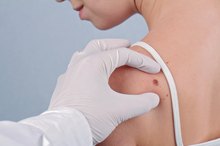What does fact checked mean?
At Healthfully, we strive to deliver objective content that is accurate and up-to-date. Our team periodically reviews articles in order to ensure content quality. The sources cited below consist of evidence from peer-reviewed journals, prominent medical organizations, academic associations, and government data.
- Medline Plus: Cutaneous Skin Tags
- Cleveland Clinic: Moles, Freckles, Skin Tags, Benign Lentigines and Seborrheic Keratosis
The information contained on this site is for informational purposes only, and should not be used as a substitute for the advice of a professional health care provider. Please check with the appropriate physician regarding health questions and concerns. Although we strive to deliver accurate and up-to-date information, no guarantee to that effect is made.
Skin tags around the genitals, also called acrochordons, are small and very common skin growths that develop on the skin in the genital area. The genital area in men is defined as anywhere around the penis, scrotum or rectum and the genital area in women is defined as the area around the vulva, vagina or anus. According to Medline Plus, skin tags around the genitals are usually benign and harmless 1.
If you are experiencing serious medical symptoms, seek emergency treatment immediately.
Causes
Skin tags usually develop as a result of the friction that is created when skin rubs against skin frequently. The genitals are a common area for skin tags to develop because the area has a lot of skin folds that make it possible for the body to create a significant amount of friction. Skin tags are more common in overweight individuals than thinner individuals and usually occur after midlife, according to Medline Plus 1.
Symptoms
Early Signs of Skin Cancer and Penile Cancer
Learn More
In most cases, the only symptom of a skin tag around the genitals is the actual, visible skin growth. Skin tags differ in appearance between individuals. Some skin tags are light tan or peach-colored, whereas others can range in color from light brown to dark brown. The skin tag may lie flat against the body or be attached to the genital through a mushroom-like stalk. According to Medline Plus, the skin tag can be miniscule or up to one-half of an inch 1.
If the skin tag becomes irritated, it may cause itching or discomfort. The skin tag may also bleed if it gets caught on clothing or other areas of the skin.
- In most cases, the only symptom of a skin tag around the genitals is the actual, visible skin growth.
- The skin tag may lie flat against the body or be attached to the genital through a mushroom-like stalk.
Diagnosis
In order to diagnosis a skin tag around the genitals, a dermatologist will look at the area and eliminate other possible conditions, such as herpes viral infections. If the skin tag looks abnormal, the doctor may perform a biopsy to test for abnormalities, such as cancer.
Treatment
What Are the Treatments for Positive HPV & ASCUS?
Learn More
Treatment is not required for skin tags around the area, but may be desired for cosmetic reasons. Treatment for skin tags usually consists of removal of the entire skin growth. The growth may be cut off with a scalpel, electrically burned off or cauterized or frozen off with liquid nitrogen in a procedure called cryotherapy, according to Cleveland Clinic.
Prognosis
When skin tags around the genitals are removed, they usually do not return in the same area. Medline Plus notes that skin tags may develop in other areas, however 1.
Related Articles
References
- Medline Plus: Cutaneous Skin Tags
- Cleveland Clinic: Moles, Freckles, Skin Tags, Benign Lentigines and Seborrheic Keratosis
- Tseng HW, Ger LP, Liang CK, Liou HH, Lam HC. High prevalence of cutaneous manifestations in the elderly with diabetes mellitus: an institution-based cross-sectional study in Taiwan. J Eur Acad Dermatol Venereol. 2015;29(8):1631–1635. doi:10.1111/jdv.12664
- Tseng HW, Ger LP, Liang CK, Liou HH, Lam HC. High prevalence of cutaneous manifestations in the elderly with diabetes mellitus: an institution-based cross-sectional study in Taiwan. J Eur Acad Dermatol Venereol. 2015;29(8):1631–1635. doi:10.1111/jdv.12664
- Usatine RP, Smith MA, Chumley HS, Mayeaux EJ, Jr. Chapter 157. Skin Tag. In: Usatine RP, Smith MA, Chumley HS, Mayeaux EJ, Jr.. eds. The Color Atlas of Family Medicine, 2e. New York, NY: McGraw-Hill; 2013.
Writer Bio
Lindsay Boyers has a Bachelor of Science in nutrition from Framingham State College and a certificate in holistic nutrition from the American College of Healthcare Sciences. She is also a licensed aesthetician with advanced training in skincare and makeup. She plans to continue on with her education, complete a master's degree program in nutrition and, ultimately, become a registered dietitian.








